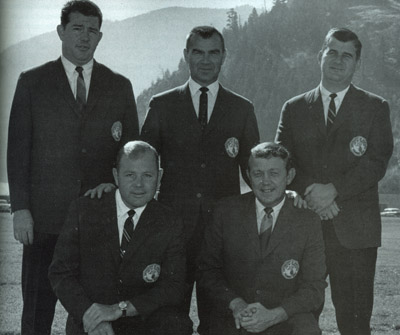Aberdeen High School’s football team thrashed Hoquiam’s last weekend in a game that was as much about the past as the present. It was the 68th time the Bobcats have beaten the Grizzlies in 108 years, making the annual gridiron faceoff between the two Grays Harbor towns – separated by one street and two provincial mindsets – the state’s oldest. It’s also the longest continual prep football rivalry west of the Mississippi. Starting early last century, the battling timber towns, birthplaces of Kurt Cobain, Jack Elway and two Nobelists, indulged in rituals of effigy burning, mascot kidnappings and spirited bar fights leading up to the game. And in a high school stadium that seated 10,000, there was often rousing football.
But, for the most part, the fun has ended. The economy and much of the two dissipated downtowns remain bleak; unemployment reigns and the local pulp mill is shut down again, its owners $94,000 short in tax payments. The annual inter-city football game was at least a respite from the depressed hum-drum, but it no longer fills Hoquiam’s 75-year-old Olympic Stadium, certainly not as it did for decades when played on Thanksgiving Day, drawing thousands home for the holiday. On Saturday, the covered wooden stands were more than half empty and Aberdeen’s dominance turned the rivalry into a lopsided show of will. In the second quarter, after scoring their third touchdown, leading 20-0 and already having outgained Hoquiam by 250 yards, the visitors rubbed it in by merrily running for a two-point conversion rather than routinely kicking for one. From there, the big Cats went on to a 36-2 pounding of the home team.
My two sisters and I, who grew up in the shadow of the stadium, are all now out-of-towners. But it pained us to watch the Grizzlies fumble and stumble to defeat again, having won just 35 times in over a century (five games were ties). One sister had been a song queen, as cheerleaders were then called, and the other dated star quarterback Elway, who went on to great fame as a coach and of course father to Hall-of-Fame son John. I played here a bit and my father of the same name played a lot – a star, crazy legged halfback and four-year letterman. His name always appeared in the thick special section devoted to past highlights of the historic game, published annually by the Aberdeen World, and he’s included in a 261-page souvenir book featuring pictures, rosters and press clips of the T-Day battles.
Though the game has gotten a recent boost by inclusion in the Great American Rivarly Series – which awards scholarships to outstanding U.S. prep players – the special newspaper sections have since vanished and the rivalry grown cool compared to the celebrated T-Day clashes, which ended in the 1970s. With Aberdeen’s enrollment around 1,000 topping Hoquiam’s by 250, the two schools are no longer even in the same league. Saturday was also my birthday, and Hoquiam’s flat game (30 net yards gained) was no present. But there was solace is seeing the game is still being covered by the Daily World’s longtime, wonderfully named sports editor, Rick Anderson. He’s from Seattle, and we’re not related, though readers sometimes confuse his byline with mine, he once told me. “They also tell me I don’t look anything like my famous football dad.”
But the real importance of this fading high school game may not have yet been realized. Would it help Grizzly fans to know their team helped revolutionize football in America? What if my sister’s boyfriend and his football coach, who was my Little League baseball coach, turned out to have helped launched and spread a style of offense that has altered the game, from high school through college, for all time? Does that ease the ache?
That’s what author Bart Wright argues in his new book, due out in two weeks. It’s an inside-football read, focused on the game’s arcane purpose of unloosing a runner or receiver for a long gain. It is also an intriguing historical playback of how Hoquiam quarterback Jack Elway and Hoquiam coach Jack Swarthout perpetrated “the” football formation.
It began when teenage Elway was Swarthout’s quarterback at Hoquiam in the late 1940s, Wright says, notching consecutive victories against Aberdeen in the Thanksgiving game. Their mission blossomed as the two went off to playing and coaching careers in college. Elway, his quarterback days cut short by a knee injury at WSU, wound up as an assistant to head coach Swarthout at Montana – (Swarthout also coached preps in Olympia and was an assistant to Darrell Royal at the UW and then Texas). Elway of course later made his own name as head coach at San Jose State and Stanford.
Over the ensuing decades, Wright, a onetime sports columnist at The Oregonian and sportswriter for the Tacoma News Tribune, tracks the two innovative coaches as they tinker with the playbook to create a game-changing offense and that attracts a crowd of disciples. “There have always been coaching pioneers, the outliers who decided to try to do something different and discovered it works,” Wright says in Football Revolution: The Rise of the Spread Offense and How It Transformed College Football. But “Swarthout and Elway are the only two coaches in America who were at the ground floor of the two modern offenses that caused the grand divergence in modern coaching strategies – the wishbone and the spread.”
Now sports editor of the Greenville News in South Carolina, Wright recalls that in Hoquiam, Swarthout ran a T-formation offense with Elway at the helm. In the following years, both would find the T inferior to the potential of the empty backfield of the spread, sending everyone out to occupy space in the opponents’ secondary. As WSU Coach Mike Leach says, “If you can complete more than 50 percent of your passes, and we typically get close to 70 percent, you’re just going to have more success that way, on balance, than being a heavy run team.”
At Montana, Wright notes, where Swarthout won two Big Sky titles, he was considered a trailblazer, but “not many reporters in those days traced his career back to Hoquiam, where Swarthout’s detailed mind had started shaking up standard football orthodoxy.” A parade of other successful coaches – Bill Walsh, Don James, Mike Price, to name a few – adopted variations of the spread as espoused by Swarthout and Elway. (Chip Kelly took it farther and faster with his no-huddle spread at Oregon, an offense successfully adopted this year by UW coach Steve Sarkisian).
Wright also credits a third Jack, Neumeier, a California high school coach, with helping spark the revolution, running a five-receiver spread with young John Elway as his prep quarterback; John’s dad was then coaching at nearby Cal State Northridge, where Dennis Erickson was one of his assistants, and they all conspired to further perfect the strategy. Erickson, whose many later head coaching stops included the Seattle Seahawks, used the spread formation to win two national championships at Miami. Mike Leach in turn credits Erickson with influencing his style of spread offense at Texas Tech and Pullman. And so on.
Swarthout died in 2005 at age 85, and Elway was 69 when he died in 2001. In Wright’s view, their revolution can be traced back to the practice field in Hoquiam, “where Swarthout’s inquisitive mind crossing paths with Elway’s explosive passing talent was the catalyst that moved each of them forward in their careers.” It’s an instructive read and, in light of 36-2, I have sent my copy of the book to Hoquiam’s current coach in hopes of sparking a new revolution or at least a decent showing.









